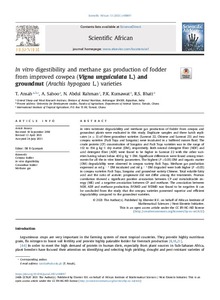| dc.contributor.author | Ansah, T. |
| dc.contributor.author | Sahoo, A. |
| dc.contributor.author | Rahman, N.A. |
| dc.contributor.author | Kumawat, P.K. |
| dc.contributor.author | Bhatt, R.S. |
| dc.date.accessioned | 2021-08-18T13:27:24Z |
| dc.date.available | 2021-08-18T13:27:24Z |
| dc.date.issued | 2021-09 |
| dc.identifier.citation | Ansah, T., Sahoo, A., Rahman, N.A., Kumawat, P.K. & Bhatt, R.S. (2021). In vitro digestibility and methane gas production of fodder from improved cowpea (Vigna unguiculata L.) and groundnut (Arachis hypogaea L.) varieties. Scientific African, 13: e00897, 1-8. |
| dc.identifier.issn | 2468-2276 |
| dc.identifier.uri | https://hdl.handle.net/20.500.12478/7212 |
| dc.description.abstract | In vitro substrate degradability and methane gas production of fodder from cowpea and groundnut plants were evaluated in this study. Duplicate samples and three batch replicates (n = 3) of three groundnut varieties (Samnut 22, Chinese and Samnut 23) and two cowpea varieties (Padi Tuya and Songotra) were incubated in a buffered rumen fluid. The crude protein (CP) concentration of Songotra and Padi Tuya varieties was in the range of 112 to 154 g kg−1 dry matter (DM), respectively. Both neutral detergent fiber (NDF) and acid detergent fiber (ADF) were found to be higher in Samnut 22 with the other varieties having values below 400 g kg−1 DM. Significant differences were found among treatments for all the in vitro kinetic parameters. The highest (P <0.05) DM and organic matter (OM) degradability were observed in cowpea variety Padi Tuya. Methane gas production expressed as ml g − 1 DM incubated and ml g − 1 DM degraded were both higher (P <0.05) in cowpea varieties Padi Tuya, Songotra and groundnut variety Chinese. Total volatile fatty acid and the ratio of acetate: propionate did not differ among the treatments. Pearson correlation showed a significant positive association between CP and metabolizable energy (ME) and a negative association between CP and methane. The association between NDF, ADF and methane production, IVOMD and IVDMD was found to be negative. It can be concluded from the study that the cowpea varieties possessed superior and efficient degradability compared to the groundnut varieties. |
| dc.format.extent | 1-8 |
| dc.language.iso | en |
| dc.subject | Cowpeas |
| dc.subject | Forage |
| dc.subject | In vitro digestibility |
| dc.subject | Groundnuts |
| dc.subject | Methane |
| dc.title | In vitro digestibility and methane gas production of fodder from improved cowpea (Vigna unguiculata L.) and groundnut (Arachis hypogaea L.) varieties |
| dc.type | Journal Article |
| cg.contributor.crp | Grain Legumes |
| cg.contributor.affiliation | Central Sheep and Wool Research Institute, Avikanagar |
| cg.contributor.affiliation | International Institute of Tropical Agriculture |
| cg.coverage.region | Africa |
| cg.coverage.region | West Africa |
| cg.coverage.country | India |
| cg.coverage.country | Nigeria |
| cg.coverage.hub | Headquarters and Western Africa Hub |
| cg.identifier.bibtexciteid | ANSAH:2021 |
| cg.isijournal | ISI Journal |
| cg.authorship.types | CGIAR and developing country institute |
| cg.iitasubject | Aflatoxin |
| cg.iitasubject | Agronomy |
| cg.iitasubject | Grain Legumes |
| cg.journal | Scientific African |
| cg.notes | Open Access Journal |
| cg.accessibilitystatus | Open Access |
| cg.reviewstatus | Peer Review |
| cg.usagerightslicense | Creative Commons Attribution-NoDerivatives 4.0 (CC BY-ND 4.0) |
| cg.targetaudience | Scientists |
| cg.identifier.doi | https://dx.doi.org/10.1016/j.sciaf.2021.e00897 |
| cg.futureupdate.required | No |
| cg.identifier.issue | e00897 |
| cg.identifier.volume | 13 |

